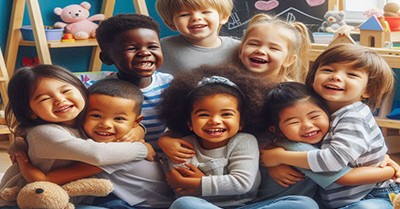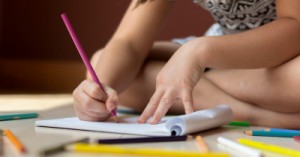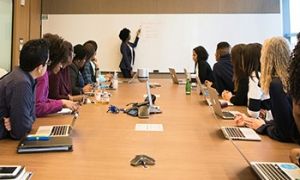The Early Years Learning Framework (EYLF) is guided by the concepts of "Belonging, Being, and Becoming," which are central to children's learning and development. The following article provides information on Understanding Belonging, Being and Becoming, Examples Of Belonging, Being and Becoming, Implementing Belonging, Being and Becoming and more.
Understanding Belonging, Being and Becoming
Belonging
Belonging is about children feeling connected to their family, community, culture, and environment. This sense of connection is fundamental to human existence and helps children understand their place in the world.
Key Aspects:
-
Relationships: Building strong, positive relationships with peers, family, and educators.
-
Inclusion: Creating an inclusive environment where all children feel valued and accepted.
-
Identity: Helping children develop a sense of identity and belonging within their community.
Being
Being focuses on children experiencing life in the present moment. It emphasizes the importance of allowing children to be themselves and enjoy their childhood without rushing through developmental stages.
Key Aspects:
-
Present Moment: Encouraging children to explore and engage with the world around them.
-
Play and Exploration: Providing opportunities for children to play and discover at their own pace.
-
Self-awareness: Supporting children in understanding their emotions, thoughts, and abilities.
Becoming
Becoming refers to the ongoing process of change and growth. It recognizes that children are always learning and developing, and it supports their journey towards reaching their full potential.
Key Aspects:
-
Learning and Development: Encouraging continuous learning and growth through various experiences.
-
Future Preparation: Equipping children with skills and knowledge for future challenges.
-
Potential: Helping children explore their abilities and strive towards their goals.
Examples Of Belonging, Being and Becoming
Belonging
Creating a sense of belonging for children in early childhood settings is essential for their social and emotional development. Here are some practical examples of how you can foster a sense of belonging:
-
Creating a Welcoming Environment:
-
Personalized Spaces: Display children’s artwork, photos of their families, and personalized items in the classroom.
-
Cultural Inclusion: Incorporate cultural elements and languages from the children's backgrounds into the learning environment.
-
-
Building Relationships:
-
Family Engagement: Involve families in school activities and events. Regularly communicate with them to build strong partnerships.
-
Group Activities: Encourage group play and collaborative projects to help children build friendships and feel part of a community.
-
-
Promoting Positive Interactions:
-
Respectful Communication: Use positive and respectful language when interacting with children.
-
Peer Support: Pair children up as “buddies” to support each other throughout the day.
-
-
Inclusive Practices:
-
Celebrating Diversity: Recognize and celebrate cultural events and traditions from different backgrounds.
-
Accessibility: Ensure that all children, including those with special needs, can participate in activities and feel included.
-
-
Establishing Routines:
-
Consistent Schedules: Maintain a consistent daily routine to provide a sense of security and predictability.
-
Morning Greetings: Start the day with a welcoming ritual, such as a group song or a special greeting.
-
-
Valuing Individuality:
-
Acknowledging Strengths: Recognize and celebrate each child’s unique abilities and achievements.
-
Supporting Identity: Encourage children to share about their families, traditions, and interests.
-
Being
Creating a sense of "Being" in early childhood education involves encouraging children to live in the present, explore their interests, and develop their identities. Here are some practical examples of how you can foster a sense of being:
-
Child-led Activities:
-
Interest-based Projects: Allow children to choose activities based on their interests, such as art, building, or nature exploration.
-
Free Play: Provide ample time for children to engage in unstructured play where they can make their own choices and follow their curiosity.
-
-
Mindfulness Practices:
-
Mindful Moments: Incorporate short mindfulness exercises, such as breathing activities or quiet time, to help children focus and relax.
-
Sensory Play: Engage children in sensory activities like sand play, water play, or exploring different textures to help them connect with their senses.
-
-
Celebrating Individuality:
-
Showcasing Talents: Create opportunities for children to share their skills and talents with the group, such as a show-and-tell session.
-
Personal Reflections: Encourage children to express their thoughts and feelings through drawing, storytelling, or journaling.
-
-
Respectful Interactions:
-
Active Listening: Show genuine interest in what children have to say and validate their feelings and experiences.
-
Positive Reinforcement: Recognize and celebrate children’s achievements, big and small, to build their confidence and self-esteem.
-
-
Exploration and Discovery:
-
Nature Walks: Take children on nature walks to explore the environment and observe the world around them.
-
Science Experiments: Conduct simple science experiments that allow children to ask questions, make predictions, and discover new concepts.
-
-
Creative Expression:
-
Art and Music: Provide a variety of materials and instruments for children to express themselves creatively through art and music.
-
Role Play: Set up role-playing scenarios where children can act out different roles and scenarios, fostering imagination and social skills.
-
Becoming
"Becoming" in early childhood education refers to the ongoing process of growth and development, where children learn and evolve through their experiences. Here are some practical examples of how you can support a child's sense of becoming:
-
School Readiness Activities:
-
Literacy and Numeracy: Engage children in activities that build basic literacy and numeracy skills, such as reading stories and counting games.
-
Fine Motor Skills: Provide opportunities for children to practice writing, drawing, and using scissors to develop their fine motor skills.
-
-
Encouraging Independence:
-
Self-care Tasks: Teach children to manage self-care tasks like dressing, feeding, and toileting.
-
Decision Making: Allow children to make choices about activities, snacks, or classroom responsibilities.
-
-
Building Relationships:
-
Social Skills: Encourage children to develop social skills by participating in group activities and learning to share, take turns, and resolve conflicts.
-
Peer Interactions: Facilitate opportunities for children to play and work together, building friendships and collaborative skills.
-
-
Promoting Confidence:
-
Positive Reinforcement: Acknowledge and celebrate children's achievements, no matter how small, to boost their confidence.
-
Encouraging Effort: Praise children's efforts and perseverance, emphasizing the value of trying and learning from mistakes.
-
-
Exploring Interests:
-
Hobby Projects: Support children in exploring their interests through projects and activities related to topics they are curious about.
-
Creative Expression: Provide materials and opportunities for children to express themselves creatively through art, music, and imaginative play.
-
-
Skill Development:
-
Problem-Solving: Engage children in activities that require critical thinking and problem-solving, such as puzzles and building blocks.
-
Physical Development: Encourage physical activities that promote gross motor skills, like running, jumping, and climbing.
-
Implementing Becoming Within The Learning Environment
-
Reflective Practices: Regularly observe and reflect on each child's development to tailor activities to their individual needs.
-
Goal Setting: Set achievable goals for each child and provide support to help them reach those goals.
-
Learning Journeys: Document children's progress and celebrate their milestones to help them see their growth over time.
Implementing Belonging, Being and Becoming
Implementing the concepts of Belonging, Being, and Becoming in an early childhood centre is essential for creating a nurturing and holistic learning environment for children. These concepts are part of the Early Years Learning Framework (EYLF) and provide a foundation for quality early childhood education. Here's how you can integrate these concepts into your practice:
Belonging
Building Relationships:
-
Family Engagement: Foster strong partnerships with families. Regular communication, family events, and involving parents in activities help create a sense of community.
-
Inclusive Environment: Celebrate cultural diversity and ensure that all children and families feel welcome and respected. Include cultural artifacts, music, and celebrations in your curriculum.
-
Peer Connections: Encourage positive interactions and friendships among children. Create opportunities for collaborative play and group activities.
Creating a Welcoming Space:
-
Personalized Spaces: Allow children to personalize their spaces with their artwork and photos.
-
Comfortable Environment: Design a cozy and inviting physical environment with soft furnishings, natural materials, and spaces for both group and individual activities.
Being
Focusing on the Present:
-
Child-Centered Approach: Respect each child's individuality and pace of learning. Provide choices and allow children to take the lead in their learning experiences.
-
Mindfulness Activities: Incorporate mindfulness activities like yoga, breathing exercises, and quiet reflection times to help children connect with their inner selves.
Valuing Play:
-
Play-Based Learning: Emphasize the importance of play in learning. Provide a variety of play experiences that promote exploration, creativity, and problem-solving.
-
Observation and Reflection: Observe children's play to understand their interests and needs. Reflect on these observations to inform your planning and interactions.
Becoming
Supporting Development:
-
Growth Mindset: Encourage a growth mindset by celebrating effort and perseverance. Help children set and achieve goals.
-
Learning Journeys: Document each child's learning journey through portfolios, learning stories, and regular assessments. Share these with families to highlight progress and achievements.
Professional Growth:
-
Continuous Learning: Engage in professional development opportunities to enhance your knowledge and skills. Reflect on your practices and seek feedback from colleagues.
-
Collaborative Practices: Work collaboratively with other educators to share insights, strategies, and best practices. Participate in professional networks and communities.
Practical Implementation Strategies
-
Inclusive Curriculum: Develop a curriculum that reflects the diverse backgrounds and experiences of the children and families in your centre. Incorporate stories, activities, and materials that are culturally relevant and inclusive.
-
Family Involvement: Create opportunities for family involvement in the learning process. Invite parents to share their skills, traditions, and experiences with the children.
-
Environment as the Third Teacher: Design the physical environment to be a rich and stimulating space that supports exploration and learning. Use natural materials, open-ended resources, and flexible spaces.
-
Responsive Teaching: Be responsive to children's interests and needs. Adapt your teaching strategies based on ongoing observations and assessments.
-
Reflective Practice: Regularly reflect on your practices and the effectiveness of your strategies. Use reflection as a tool for continuous improvement and professional growth.
By incorporating the principles of Belonging, Being, and Becoming, you create a supportive and enriching environment that fosters children's overall development and well-being.
Further Reading
Belonging, Being & Becoming Concepts Of The EYLF - The following article provides strategies to include belonging, being and becoming within the learning environment.
Free EYLF Version 2.0 Posters and Cheat Sheets - The following provides a list of cheat sheets and free printables based on EYLF Outcomes Version 2.0. These can be used as a reference point for Educators. They can also be used to refer to when documenting and planning.
Definition Of Belonging, Being and Becoming For Educators - The Early Years Learning Framework recognizes the inextricable links that belonging, being and becoming have with learning. As part of this recognition, the framework elaborates learning outcomes, principles and practices for educators that will help them meet their professional goals while ensuring personal growth and well-being too. The following article provides definitions of belonging, being and becoming.







 Here is the list of the EYLF Learning Outcomes that you can use as a guide or reference for your documentation and planning. The EYLF
Here is the list of the EYLF Learning Outcomes that you can use as a guide or reference for your documentation and planning. The EYLF The EYLF is a guide which consists of Principles, Practices and 5 main Learning Outcomes along with each of their sub outcomes, based on identity,
The EYLF is a guide which consists of Principles, Practices and 5 main Learning Outcomes along with each of their sub outcomes, based on identity, This is a guide on How to Write a Learning Story. It provides information on What Is A Learning Story, Writing A Learning Story, Sample
This is a guide on How to Write a Learning Story. It provides information on What Is A Learning Story, Writing A Learning Story, Sample One of the most important types of documentation methods that educators needs to be familiar with are “observations”. Observations are crucial for all early childhood
One of the most important types of documentation methods that educators needs to be familiar with are “observations”. Observations are crucial for all early childhood To support children achieve learning outcomes from the EYLF Framework, the following list gives educators examples of how to promote children's learning in each individual
To support children achieve learning outcomes from the EYLF Framework, the following list gives educators examples of how to promote children's learning in each individual Reflective practice is learning from everyday situations and issues and concerns that arise which form part of our daily routine while working in an early
Reflective practice is learning from everyday situations and issues and concerns that arise which form part of our daily routine while working in an early Within Australia, Programming and Planning is reflected and supported by the Early Years Learning Framework. Educators within early childhood settings, use the EYLF to guide
Within Australia, Programming and Planning is reflected and supported by the Early Years Learning Framework. Educators within early childhood settings, use the EYLF to guide When observing children, it's important that we use a range of different observation methods from running records, learning stories to photographs and work samples. Using
When observing children, it's important that we use a range of different observation methods from running records, learning stories to photographs and work samples. Using This is a guide for educators on what to observe under each sub learning outcome from the EYLF Framework, when a child is engaged in
This is a guide for educators on what to observe under each sub learning outcome from the EYLF Framework, when a child is engaged in The Early Years Learning Framework describes the curriculum as “all the interactions, experiences, activities, routines and events, planned and unplanned, that occur in an environment
The Early Years Learning Framework describes the curriculum as “all the interactions, experiences, activities, routines and events, planned and unplanned, that occur in an environment


